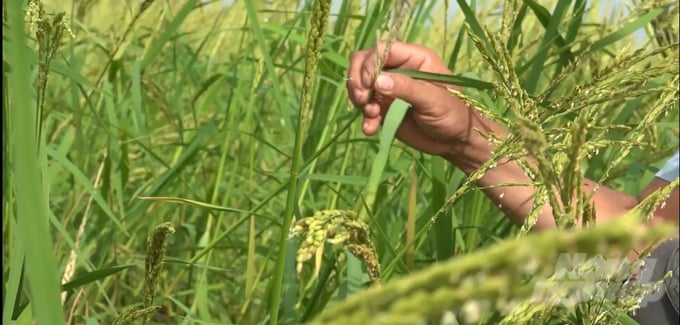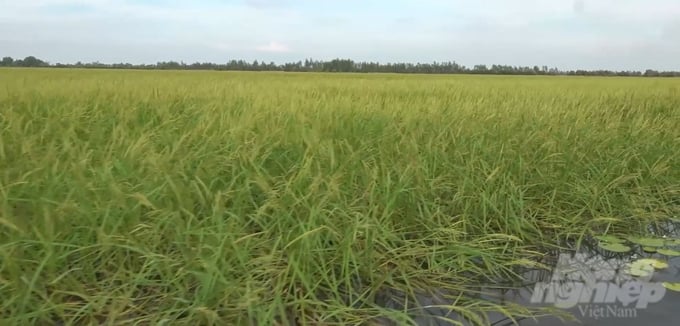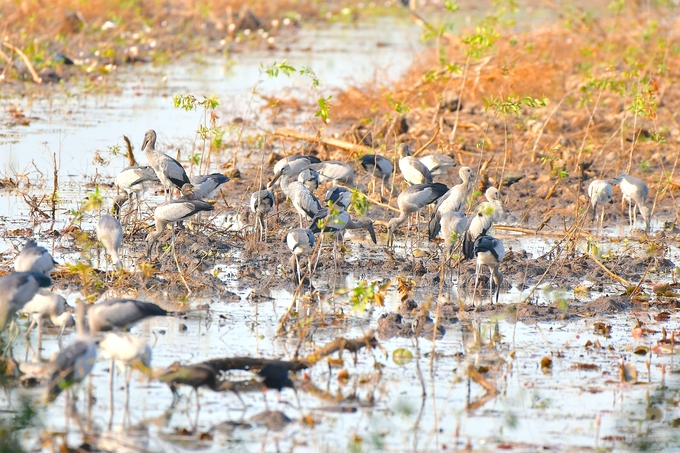May 16, 2025 | 13:00 GMT +7
May 16, 2025 | 13:00 GMT +7
Hotline: 0913.378.918
May 16, 2025 | 13:00 GMT +7
Hotline: 0913.378.918
People in Long An province are participating in three main models to improve their livelihoods, which are the rice-fish model, the water hyacinth weaving model, and the model of floating rice growing using the Nang Tay Dum variety.
In particular, the floating rice growing model deployed by the World Wide Fund for Nature in Vietnam (WWF-Vietnam) in Vinh Dai and Vinh Chau A communes, Tan Hung district (Long An), has initially shown signs of economic efficiency and biodiversity conservation.

The model of floating rice growing using the Nang Tay Dum variety brings to farmers a profit of 10–12 million VND/ha. Photo: VAN.
Regarding economic efficiency, farmers participating in this livelihood model will have income from rice growing and fishing activities in rice fields. According to the Vinh Dai Commune People's Committee, in recent years, the average rice yield reached 1 ton/ha, reducing significantly compared to before due to the influence of weather. However, with the current purchasing price of 15,000 VND/kg, farmers still earn a profit of 10–12 million VND/ha. Farmers also earn an additional income of 3-5 million VND/ha from fish.
Regarding biodiversity conservation, Mr. Huynh Quoc Tinh, representative of WWF-Vietnam, said: "The floating rice model we deployed in the buffer zone of Lang Sen Wetland Reserve initially had quite good and positive environmental records."
According to Mr. Huynh Quoc Tinh, the amount of alluvium deposited in this floating rice model is 3 times higher than the 3-crop rice farming model, while the amount of water stored for reimbursement is nearly 20 times higher. Besides, the number of aquatic and fish species is also higher than in 3-crop rice growing areas as well as other areas.

The amount of alluvium deposited in this floating rice model is 3 times higher than the 3-crop rice farming model. Photo: VAN.
In addition to the livelihood model of restoring floating rice for people in the buffer zone, among the projects that WWF-Vietnam implemented in this land are also many other projects bringing sustainable livelihoods. Since implementing these projects, the lives of people in this buffer zone have changed positively.
Sharing with Vietnam Agriculture Newspaper, Assoc. Prof. Dr. Nguyen Phu Son said that sustainable livelihood includes up to five types of assets: human, natural, financial, social, and physical. Since WWF-Vietnam implemented projects to bring livelihoods for people in the buffer zone, there are two types of assets that have shown positive signs, which are human assets and social assets.
"The reason I say that is only when WWF's projects as well as other projects and programs participated in this area did people here begin to participate in activities and forms of business or diversify their income through many different occupations," said Assoc. Prof. Dr. Nguyen Phu Son.

Activities to improve livelihoods for people in the buffer zone that Lang Sen Wetland contributed to protecting the plant and animal ecosystem here. Photo: Hoang Vu.
Despite initial efficiency, in order to more effectively implement the projects to improve the lives of people in the buffer zone of Lang Sen Wetland Reserve in the coming time, it requires the participation of the whole community, including the Reserve Management Board as well as the local government of Tan Hung district, Long An province. As an organization with a project continued for the following years, WWF-Vietnam made some recommendations.
Representative of WWF-Vietnam Huynh Quoc Tinh said that the project's orientation is to help the community have more sustainable choices and accelerate progress during the flood season. Within the framework of the project, WWF-Vietnam wishes to build capacity for the community and locality there and for the national park management board. After the project ends, it is recommended to have a mechanism for the model to continue to be maintained.
Besides, the representative of WWF-Vietnam also hopes that the locality will coordinate with projects and businesses to disseminate and raise people's awareness about the benefits and balance between short-term and long-term benefits in preserving biodiversity and their livelihoods.
"We also wish the local government to support projects and programs that the State is supporting investment, because through those programs and projects, people can receive additional support in terms of capacity, techniques, or technology to be able to enhance the product value. Combined with the story built on this Lang Sen Wetland Reserve, I hope that the added value of the product will be better and meet people's livelihoods while still preserving the value of this wetland," said Mr. Huynh Quoc Tinh.
In recent times, activities to improve livelihoods for people in the buffer zone that Lang Sen Wetland Reserve coordinates with international organizations, typically WWF-Vietnam, have contributed to limiting people's illegal entry to catch aquatic products and wild animals, thereby protecting biodiversity for the plant and animal ecosystem here.
Translated by Thu Huyen

(VAN) Cold-barn systems efficiently manage environmental and temperature conditions, which aids in the prevention of respiratory diseases in pigs and protects them from the vectors that transmit African swine fevers.

(VAN) To tackle challenges, the project 'Addressing key technical bottlenecks in the grouper supply chain in Vietnam' has been underway since 2024.

(VAN) The project 'Disease-Resilient and Sustainable Cassava Production Systems in the Mekong Region', funded by the Australian Center for International Agricultural Research (ACIAR), is being implemented from 2024 to 2028.

(VAN) Data from 10,000 farming households will help professionalize production organization and support the implementation of the One Million Hectares Program for High-Quality, Low-Emission Rice Cultivation.

(VAN) FAO Director-General QU Dongyu marks International Day of Plant Health at NENA conference.

(VAN) Deputy Minister of Agriculture and Environment Hoang Trung affirmed that floriculture and ornamental plants are a growing industry that receives significant global attention.

(VAN) The three staple crops dominating modern diets – corn, rice and wheat – are familiar to Americans. However, fourth place is held by a dark horse: cassava.